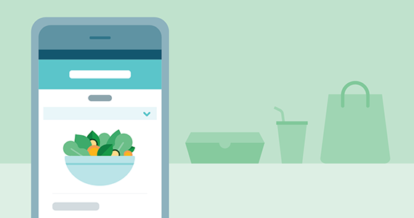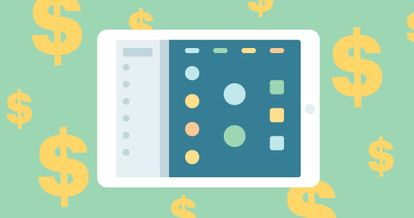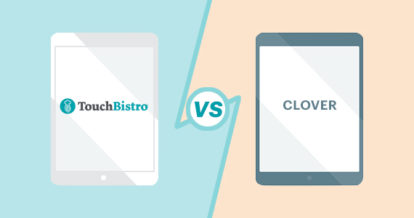The number one thing customers want with their takeout isn’t a side of fries. It’s online ordering convenience.
A study on the rise of online ordering systems revealed that 51% of Americans have used a restaurant delivery service to purchase meals, and 26% order at least once a week.
Research by HungerRush shows that 79% of diners expect the option to use technology to order from casual restaurants shows that for nearly one-third of all adults and 41% of people aged 18 to 34, the availability of technology options is an important factor when choosing restaurants.
In an era of right now or never, customers have come to expect that food delivery be effortless, available at all hours, and at their fingertips. The online ordering business overall was worth $5 billion for the first two quarters of 2018 alone, and some experts predict that the food delivery market could be valued at $365 billion by 2030.
Though online ordering was already on the rise, it has become even more important in recent years. Now, an online ordering system can help streamline your restaurant’s curbside takeout system, simplify food delivery, and provide a valuable source of ongoing revenue.
But because we know getting started involves a lot of operational overhaul, we’re ready to help you break it down.
In this article, we’ll cover everything you need to know about preparing for and working with an online ordering system, including:
- What is online ordering?
- Three different ways to do online ordering
- Top three benefits of third-party apps
- The fee structure of third-party online ordering systems
- Four steps to prepare for restaurant ordering system software
Want to get started with online ordering right away? TouchBistro Online Ordering lets diners order directly from you. Plus, TouchBistro Online Ordering integrates with DoorDash Drive, making it easy for your restaurant to offer delivery. Gain access to an on-demand network of local drivers for quick and convenient delivery and pay $0 in commission.
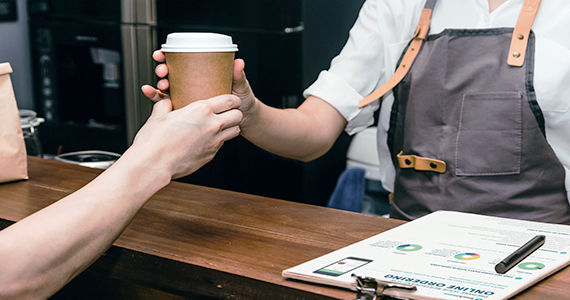
Not sure how to get your restaurant ready for takeout and delivery?
What Is Online Ordering?
Online ordering for restaurants is the technology that gives customers the ability to place a takeout food and/or beverage order through a restaurant’s website, app, or third-party app, either on a mobile device or desktop – often with delivery included.
An online ordering system collects all the necessary information about the order (customer info, items, payment) and allows a restaurant to receive and process these orders – either directly or indirectly – through their POS.
Most direct online ordering systems are also equipped with integrated payments so customers can pay for their order online right after placing it.
There are three main types of online ordering systems restaurants can use.
1. Your Own Website
An online ordering system that lives on your website allows customers to order takeout and delivery from you directly, which means you keep more of the profits but you also get all the work.
You have to set up your website, which means building your own interactive online menu, integrating payments (eliminating the financial risks of placed orders that never show), and organizing delivery (adding labor costs and assuming additional insurance risks).
Fortunately, there are some POS solutions that can help you add online ordering directly on your website. One example is TouchBistro Online Ordering with integrated payments, which lets diners order and pay directly from your website. Customers can place orders for right now or schedule them for later, and all the information is streamlined directly into your POS.
Additionally, TouchBistro Online Ordering integrates with DoorDash Drive – a seamless delivery solution built just for restaurants. With this integration, you can tap into a network of on-demand local drivers to get your orders from door to door for a flat fee, while paying $0 in commission.
So how do they work in your restaurant?
- Customers can use an online ordering tool on your restaurant’s website to place and pay for takeout and delivery orders.
- Online orders flow directly from your website to your POS in real-time, so staff are notified as soon as a new order has been placed or scheduled.
- Staff then need to coordinate pickup or drop offs with the restaurant’s own delivery fleet.
- A staff member also needs to keep an eye on variables such as menu updates, adjusting delivery and pickup wait times, setting ordering hours, close dates, and delivery zones.
Keep in mind that if you use a third-party takeout and delivery app that is not integrated with your POS, someone within your restaurant needs to monitor your online orders closely, paying attention to your POS inventory and/or communicating with the kitchen to make sure items are taken down when they’re no longer available – or you’ll end up needing to contact the customer directly to offer an alternative item or refund. Not a fun call to make.
Regardless of what type of online ordering system you have, you also need to consider your audience. Odds are, your diners are ordering from other mobile apps already, so they may not be looking to your website to place an order. This means the in-house website route may not give you the volume you need. As a result, you may need to use third-party apps in addition to your online ordering on your website.
Main takeaway: Online ordering through your own website grants convenience to existing customers and allows you to keep all the profits from those orders.

2. Third-Party Online Ordering App
Third-party online ordering apps, like Uber Eats, and Grubhub, house an extensive list of restaurants, sorted by location and food type, so that customers can browse and order from individual menus on their phone or desktop.
A virtual food hall, a third-party app gets you in front of hungry customers in your area who are ready to buy.
While some of these apps focus on order-ahead takeout that customers pick up, many also offer independent contractors to deliver food from your restaurant directly to the customer, which means you don’t have to hire, train, and pay for that labor.
So how do they work in your restaurant?
- A staff member monitors orders that come in through the third-party app iPad or tablet.
- They accept or decline the order.
- Then they manually add the order to the restaurant’s own POS.
- Many restaurants in busy, urban areas work with multiple third-party apps, so this staff member might manage multiple tablets.
- They also deal with the independent delivery drivers, communicating with the kitchen to get an order ready and out the door with the correct person.
The biggest consideration here is cost, since most third-party apps charge restaurants on a per transaction basis. The increased exposure – and therefore traffic – has to be at a high enough volume to offset the cost, which we’ll talk about more below.
Main takeaway: Your customers (existing and new) get convenience, and you get new traffic plus increased takeout revenue – but you have to give another company a piece of the pie.
3. Third-Party Online Ordering System with POS Integration
A third-party online ordering app with POS integration, such as Deliverect, is a centralization of all the third-party apps you use in one location: your POS.
Essentially, Deliverect acts as a bridge between your third-party online ordering platform and your POS. The integration takes the third party orders and streamlines them directly into your POS, so you don’t have to manage more than one system or manually enter orders – a big help for your operation efficiency, seeing as 5% of all manually entered orders contain at least one error. That could end up costing you $4,000 per year in lost revenue!*
*Based on TouchBistro’s estimate of a restaurant’s average annual online ordering revenue.

So how do they work in your restaurant?
- Customers order from your restaurant using the third-party online ordering app of their choice.
- Because the two systems – the third-party app and your POS – can talk to each other, your takeout staff doesn’t have to stress over orders getting lost or entered incorrectly.
- Staff acknowledge the order directly on your POS.
- Staff don’t have to stay glued to third-party tablets – they get to engage in other tasks, like boosting sales and making sure customers are getting a great experience.
- You can measure how each of your online ordering platforms is performing through your POS reporting, together in one single view (without a POS integration, you have to view each platform’s separate reports).
- You’re able to make informed decisions about which platforms are best for your restaurant.
This POS integration creates an online ordering system for businesses that are ready to scale this revenue stream, making the most of all available platforms.
Again, the biggest consideration here is cost, because you’ll have per transaction fees from both the third-party app and integration app. It’s important to consider what your takeout volume is – or has the potential to be – when looking into this option. Third-party online ordering with POS integration is ideal for restaurants that anticipate high volumes of orders from one or multiple apps.
Main takeaway: You and your customers get convenient online ordering that’s easy and streamlined on both sides of the transaction – but at a slightly higher cost. But if you have the volume, the convenience points are worth it.
Third-Party Online Ordering System Cost
Since cost is a major factor to consider for any third-party online ordering system, let’s take a look at the fee structure for these apps to help you navigate the costs.
Most of these third-party apps work on a three-tiered fee structure.
1. Set-up: This is usually a one-time fee to get everything up and running on the map, add your online menu to the app, and it includes the hardware and software to your restaurant.
Range: $0–$400
2. Transaction: Most apps charge a per transaction fee, usually a percentage of each order or of net online sales made through the app. The fees are different depending on your restaurant’s area, with busier areas typically having higher fees. Some apps charge a flat monthly fee, but it’s not as common.
Range: 10%–40% of each transaction; some have flat monthly fees
3. Marketing: On top of your listing as a local restaurant on the app, you can also get in-app marketing services, like priority placement, promoted listings, and featured offerings that make it easier and/or more appealing for customers to choose your restaurant. These services are optional, best for restaurants looking to really ramp up takeout volume.
Range: These fees vary widely, depending on the third-party app and the marketing service. This means that depending on the volume of orders you’re processing, the fees sometimes outweigh the benefits.
The Importance of Online Ordering Systems
Whether you choose to go with direct online ordering on your own website, a third-party food delivery service, or some combination of the two, it’s clear that online ordering can have some major benefits for your restaurants. Some of the biggest benefits of online ordering include:
- More customers
- More sales
- More efficient ordering and paying
- A better customer experience
What does that add up to for your restaurant? Incremental revenue – revenue earned by increasing production.
Translation? You make more money.

More customers: Stop chasing after more traffic for your restaurant – third-party apps and online ordering software bring the traffic to you. The State of Full Service Restaurants in 2020 report found that FSRs that implemented online ordering saw an impressive 11% to 20% increase in revenue. Plus, a study by Grubhub found that, on average, restaurants using their online ordering service grew their revenue by 30%. One in five doubled their takeout revenue.
More sales: Because people tend to order more when using a self-serve ordering system – both with kiosks and online ordering – your average check size for takeout orders will likely increase. Our annual report also found that customers spend up to 20% more on online orders – due to both more add-ons and more menu items per check. A higher volume of orders and more sales per order.
More efficient ordering and paying: Nobody wants to pick up the phone to place a takeout order anymore. With a third-party app or online ordering on your website, orders and payments are processed instantly.
Better customer experience: Online ordering gives customers the ability to order when and where they want to, without the kinds of communications issues that typically occur with call-in orders. Apps and website online ordering make it easy to customize an order, schedule it for a specific time and date, and pay it in just a few clicks – no matter how long or complicated. The customer gets a digital receipt for their custom order and the ability to track their delivery or pick-up time. And with integrated payments, customers can pay for their order entirely online.

Not sure how to get your restaurant ready for takeout and delivery?
4 Steps to Prepare Your Restaurant for Online Ordering
If you’re new to online ordering, the process can seem overwhelming. We’re here to break down the steps you need to take to choose the best food delivery service and set yourself up for success with this new source of incremental revenue.
1. Popularity Contest: Know the Top Third-Party Apps in Your Area
You’ll want to think about more than just price when you’re choosing an online ordering system/third-party app. First you need to know which ones are the most popular in your area.
And every area is different.
Restaurant Business studied the five most popular third-party apps – Grubhub, Uber Eats, DoorDash, Eat24, and Postmates – and broke down their share of each market for some of the biggest cities across the U.S.
Popular online ordering apps in New York
Grubhub: 85.1%
Uber Eats: 8.2%
Postmates: 3.0%
DoorDash: 1.9%
Eat24: 1.9%
Popular online ordering apps in L.A.
Postmates: 33.1%
Grubhub: 19.6%
DoorDash: 19.6%
Uber Eats: 15.9%
Eat24: 11.7%
Popular online ordering apps in Chicago
Grubhub: 59.3%
Uber Eats: 18.0%
DoorDash: 12.9%
Postmates: 6.9%
Eat24: 2.9%
Popular online ordering apps in Boston
Grubhub: 65.9%
Uber Eats: 14.5%
DoorDash: 11.9%
Eat24: 5.5%
Postmates: 2.0%
Popular online ordering apps in Washington D.C.
Grubhub: 39.5%
Uber Eats: 31.7%
DoorDash: 13.7%
Eat24: 7.9%
Postmates: 7.3%
Popular online ordering apps in Dallas
Uber Eats: 47.9%
DoorDash: 32.4%
Grubhub: 13.7%
Eat24: 3.2%
Postmates: 2.3%
Popular online ordering apps in San Francisco
DoorDash: 36.7%
Uber Eats: 18.3%
Grubhub: 17.7%
Eat24: 14.2%
Postmates: 13.1%
Depending on where your restaurant is – and therefore which app or apps people are using the most – you may only need to focus on one to capture the majority of the market (like in New York where Grubhub claims more than 85% of the market) and a high volume of orders. Or, you may need three or four to get the volume increase you need (like in LA, where the market share is pretty evenly spread).
That’s why it’s important to do your homework in order to find the best food delivery app for your restaurant. Research online and investigate each third-party app to see how many customers are using it in your area. Use that information to determine the best way to capture as much of this audience as possible.
Full Service Restaurant Looking for Online Ordering Trends?
In The State of Full Service Restaurants in 2022, we looked at which online ordering platforms are used most commonly by full service restaurants (FSRs) in some of the biggest cities in the U.S. Our report findings echo the larger consumer trends discussed above.
FSRs That Use Online Ordering Platforms in New York City
Uber Eats: 58%
DoorDash: 49%
Grubhub: 44%
Own website: 36%
Postmates: 26%
Other third-party apps: 6%
FSRs That Use Online Ordering Platforms in L.A.
Uber Eats: 59%
DoorDash: 29%
Grubhub: 33%
Own website: 22%
Postmates: 14%
Other third-party apps: 1%
FSRs That Use Online Ordering Platforms in Dallas
Uber Eats: 71%
DoorDash: 48%
Grubhub: 54%
Own website: 12%
Postmates: 33%
Other third-party apps: 3%
2. All Aboard! Prepare Your Staff for the New Workflow
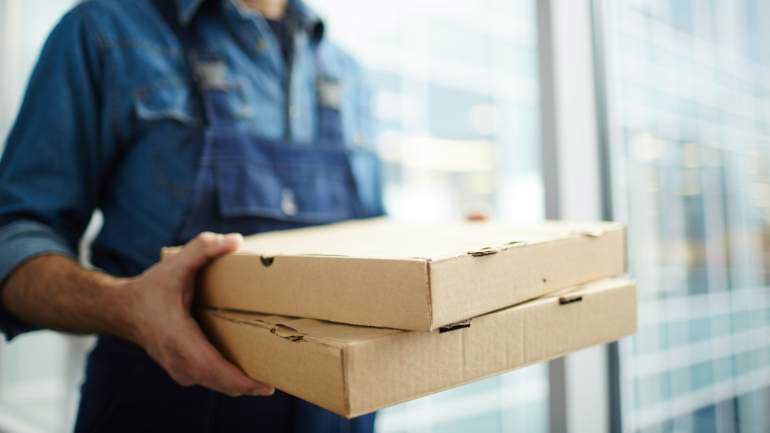
Once you’ve completed your research and added online ordering to your website or chosen your third-party app(s), you’ll need to inform and train your staff for the coming changes – to their roles, to the influx of new customers, and the onslaught of takeout and delivery orders.
Front of house
Step 1: Get strategic about your restaurant flow
Decide how you want customers to move through your restaurant, knowing you’ll have a lot more takeout traffic. Train your front-of-house staff to manage this flow, checking in with customers and on the status of their orders. And don’t forget to keep physical distancing guidelines in mind, even if guests are simply coming in to pick up takeout orders.
Step 2: Create a designated takeout area
Help your staff manage the flow of traffic by designating a specific waiting area for customers and food delivery drivers who are picking up. The waiting area should be away from your restaurant’s main flow of traffic, to avoid any bottlenecks and ensure proper social distancing is possible during your busiest times.
Step 3: Add signage to direct customers
Put up clear, visible signage that helps customers and delivery drivers easily find the waiting area, instead of ending up in the wrong line. Make sure your signs also remind customers and drivers to keep six feet of distance from one another.
Step 4: Create a new takeout job description
Carve out a new role at your restaurant for takeout orders, so at least one person per shift is dedicated to entering orders from third-party apps into your POS. If you’ve opted for an online ordering integration that streamlines orders directly into your POS, this staff member may be able to take on other responsibilities as well.
Look for someone with a keen eye for detail. They have to pay close attention to the incoming orders and double, triple, quadruple check that it’s entered correctly.
They also have to be fast and efficient. On average, it takes about one to two minutes to manually type in an order. The faster these orders are entered (without mistakes), the faster the kitchen can start making them, and the faster they get to the customer. And fast, convenient service will get you happy customers and more sales.
Step 5: Assign additional tasks
Train your takeout specialist for tasks beyond monitoring and manually entering orders, such as coordinating with delivery drivers and communicating with the kitchen on order times and 86’d items.
If you track inventory using your POS, items will automatically get 86’d in your system when you’re out of stock. But make sure your staff know to update the third-party apps with this info, so customers can only order what’s in stock.
Step 6: Develop a “declined order” process
If you’re using a third-party app that is not integrated with your POS, you’ll need to put a “declined order” process in place for staff to follow, so they know what to do if an out-of-stock order from a third-party app comes in before they’re able to 86 it. They’ll be able to “decline” the order easily on the third-party tablet, so the customer won’t be charged, but you’ll also want to send a message through the app with an apology and some effort to make up for the inconvenience: a comparable item, a rain check, a special offer, etc.

Not sure how to get your restaurant ready for takeout and delivery?
Back of house
Training for back-of-house staff will be less focused on different roles and workflows, and more focused on the increased workload.
Online ordering will definitely boost the number of orders your back of house needs to prepare. But what kind of volume increase are you looking at? Every restaurant will be different.
Step 1: Optimize your current kitchen staff
Before making any hiring or rehiring decisions, maximize the efforts of your current staff. Prior to launch, look for ways to be as efficient as possible in the kitchen: optimize your layout, prep food packaging, time orders to maintain consistency, etc.
Step 2: Set up a trial period
Use the first few weeks of online ordering as your trial period for back of house, which will help you determine if you need to rehire furloughed staff or hire new ones for different roles. The rate of sales growth will also help you predict future hiring needs.
Step 3: Monitor workload during your trial period
Monitor online sales during this trial period and its impact on your kitchen staff, taking advantage of on-the-go reporting apps that keep you on top of what’s happening from wherever you are. Also, talk to staff and get their feedback on any backlogs or issues that are occurring during specific hours of operation. They’re your eyes and ears on the ground – so use ‘em!
Step 4: Determine your hiring needs
If you do need to rehire furloughed staff or hire new staff, consider starting with an expediting role, someone dedicated to organizing and prioritizing online orders, as well as communicating with their front-of-house counterpart.
3. The Menu Is the Message: Optimize Your Menu for Online Ordering
Optimizing your menu for this online format is a super important step. Why? You already have a menu, right?
Not this kind of menu.
An online menu will not only be read differently than your printed version, customers will also interact with it differently. It has to be designed for easy navigation and upselling.
We suggest building one menu specifically for online ordering, concentrating on the following aspects:
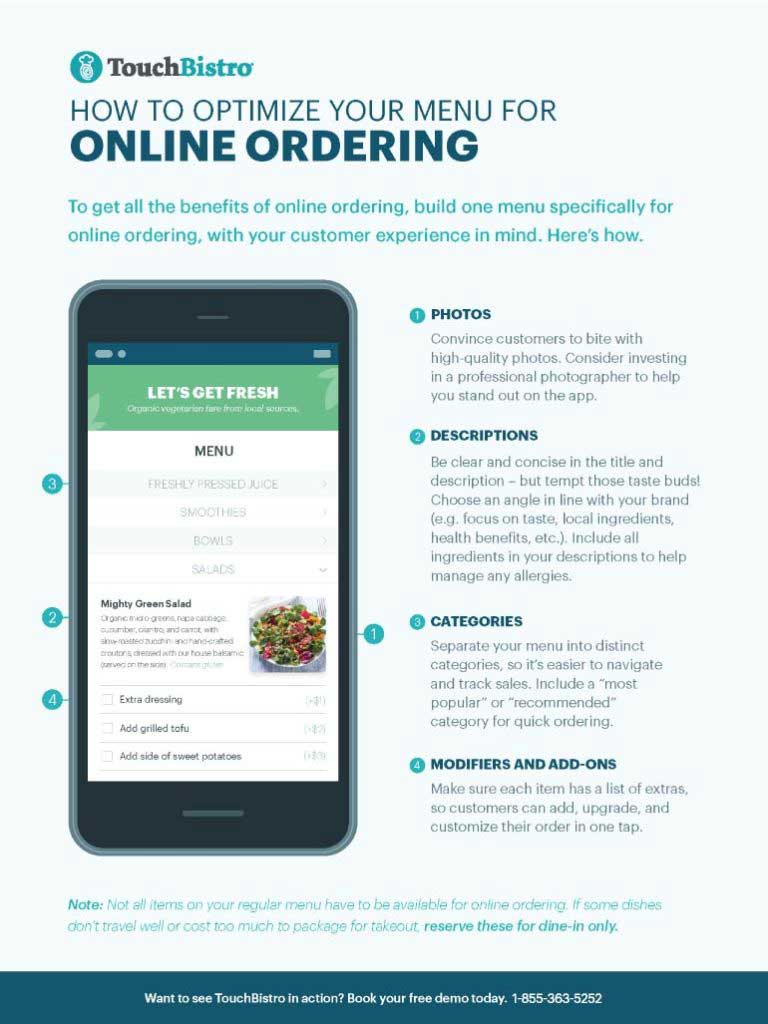
Photos
Showcase your delicious food and drink with high-resolution photos, helping you stand out on your website and third-party apps. Consider investing in a professional photographer to capture your menu at its best.
We often order with our eyes, so having drool-worthy visuals of each dish on your menu will help convince customers to bite – especially for new customers who aren’t yet familiar with how great your food is.
Descriptions
Your written description helps customers decide what to order. You want these words to be clear and concise, but also as tempting as possible.
Have an angle in mind when crafting these titles and descriptions, something that fits with your brand. Focus on taste, local ingredients, health benefits, etc., and incorporate this angle into how you describe the dish, the way it’s cooked, etc.
For example:
Mighty Green Salad
Organic micro-greens, napa cabbage, cucumber, cilantro, and carrot, with slow-roasted zucchini and hand-crafted croutons, dressed with our house balsamic (served on the side).
Like in the example above, the description should also list all ingredients, which helps prevent frustrated customers who open up their delivery order and find cilantro (when they hate it) or peanuts (when they’re allergic).
Similar to what you did with the photos, consider hiring a professional writer to help with your descriptions. Remember that you are competing with other local restaurants – many of which now offer takeout and delivery as well – so you want any advantage you can get.
Categories
Your current menu design may already have categories, but you may need to rethink your structure. Think about how your menu will appear on a small screen. The more you can separate your menu into distinct categories, the easier it will be for customers to navigate – and for you to track sales. The less scrolling a customer has to do, the better.
Make sure to include a “most popular” or “recommended” category that helps customers choose your biggest sellers (and hopefully highest profit margin items) as quickly as possible.
Modifiers and add-ons
Design your online ordering menu so that each item provides a list of extras customers can add or upgrade. In one tap, customers can customize their order. Instant upsell.
On average, customers spend about $4 more on digital orders. Capitalize on that trend by presenting options that add more to your sales without adding much to your workload.
How modifiers and add-ons make you more money
A typical pad Thai ($10)
Choose your meat
Shrimp + chicken ✔️
Tofu
Beef (+$1)
Shrimp (+$2)
Suggested add-ons
Family size, perfect for sharing (+$3)
Brown rice noodles (+$2)
Extra veggies (+$1) ✔️
Thirsty? Add a gourmet soda.
Ginger ale (+$3)
Natural cola (+$3) ✔️
Sparkling lemonade (+$3)
How about an appetizer?
Spring roll (+$2) ✔️
Tom Yum soup (+$4)
Chicken satay (+$5)
Mango salad (+$4)
PAD THAI = $10
WITH UPSOLD MODIFIERS + EXTRAS = $16
CHECK SIZE INCREASE = 60%
They get customized orders and you get a higher average check size. There’s no downside!
Note: Not all items on your regular menu have to be available for online ordering. If certain dishes don’t travel well or cost too much to package for takeout, remove them from your online menu and reserve these for dine-in (if that’s an option).
4. Develop Your Marketing Strategy
Not sure how to market your restaurant for online ordering? No problem.
The great thing about third-party online ordering is that the system in and of itself provides a ton of marketing, getting your restaurant attention through the app’s listing and search function. Plus, companies like Grubhub and Uber Eats invest a lot of time and resources into marketing their platforms to increase the number of users, which in turn helps you get in front of more eyeballs.
However, the drawback to using third-party apps as a marketing tool is that it’s gonna cost you. If you have a direct online ordering system on your website, you’ll want to prepare your own marketing strategy to maximize exposure and revenue. Let your customers know – through email, social media, your website, and other channels – that they can order from you directly and that it’s the best way to support your business. This will help maximize your potential for new revenue through your chosen platform(s) and give customers a way to safely enjoy your food if they don’t yet feel comfortable dining in.
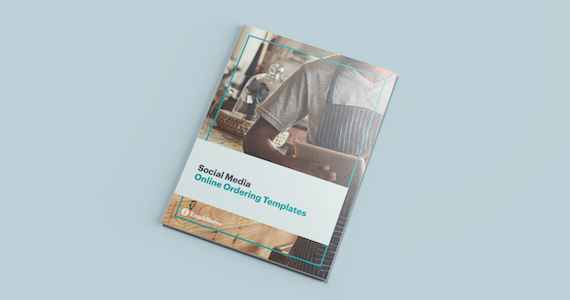
Drive sales and brand awareness with our free social media templates for restaurants.
In-store signage
Set up street-facing signage that advertises online ordering from your website or which apps you’re on. Potential customers walking by will know where they can find you and place an order with a few taps.
Website advertising
Add a banner, blog post, or button that shows which restaurant online ordering system you’re using and if you offer delivery. This lets customers know exactly how to get takeout and delivery from you without picking up the phone. Plus, make sure your website is mobile-friendly, which will make it easier for customers on their phones to see what your restaurant is all about.
Social media
Get the word out on Facebook and Instagram, along with some of those tantalizing, high-quality photos of your food – the same photos you used on your online ordering menu. Consider investing in paid ads on these platforms as well, targeting users in your area, and letting them know your online takeout and delivery options.
Promotions or discounts
A great way to attract users in the app and start building your takeout volume is through coupons and promotions. Work with your third-party app to introduce promotional codes or automatic discounts on a customer’s first order or on a new menu item. Providing an extra incentive may give someone the push they need to try out your restaurant.
In-app search
This is where the marketing services we mentioned (in the fee structure section) come into play. Work with account representatives from each platform you’re on to help you optimize where and how your restaurant appears in search results. It comes at a cost – of course – but can be a really effective part of an overall marketing strategy, especially when you first launch online ordering.
Online ordering is a great way to grow your customer base and your sales. To get started with online ordering right away, learn more about TouchBistro Online Ordering.
TLDR?

Not sure how to get your restaurant ready for takeout and delivery?
Free online ordering signs for your restaurant
Sign up for our free weekly TouchBistro Newsletter

